Best Korean Soups & Stews: Recipes

Ever wondered why Korean soups and stews make you feel so cozy? They’re more than just food. They’re comfort in a bowl. Let’s explore the world of Korean cuisine together.
Imagine the spicy kick of Kimchi Jjigae or the deep flavor of Doenjang Jjigae. Each dish has its own story and taste. They’re loved in every Korean home.
Discover the health benefits of these dishes. Learn how easy it is to make them. Whether you’re an expert or just starting, Korean soups will inspire you.
Ready to dive into the world of Korean soups? You’ll learn what makes them so special. Each bowl is a journey of flavors and feelings.
Introduction to Korean Soups & Stews
Korean soups and stews are loved by many. They are a big part of family meals and celebrations. These dishes are not just tasty, but also good for you, warming your heart and body.
What Makes Korean Soups Unique?
Korean soups and stews are different. Soups, called guk, are light and broth-like. Stews, or jjigae, are thicker and full of flavor.
The names tell us how they are made. -guk and -tang mean they simmer for a long time. -jjigae means they cook faster.
Key Ingredients to Use
Many ingredients go into Korean soups and stews. You’ll need fresh veggies, meats, and spices. gochujang and kimchi are key for their taste.
kimchi jjigae starts with kimchi for a strong flavor. Samgyetang, or ginseng chicken soup, is quick to make. It’s a comforting dish.
The Importance of Broth
A good broth is the heart of Korean soups and stews. It’s made by simmering bones or meat with spices. This broth brings all the flavors together.
Enjoying these soups with banchan, small side dishes, makes the meal better. It adds variety and balance to your meal.
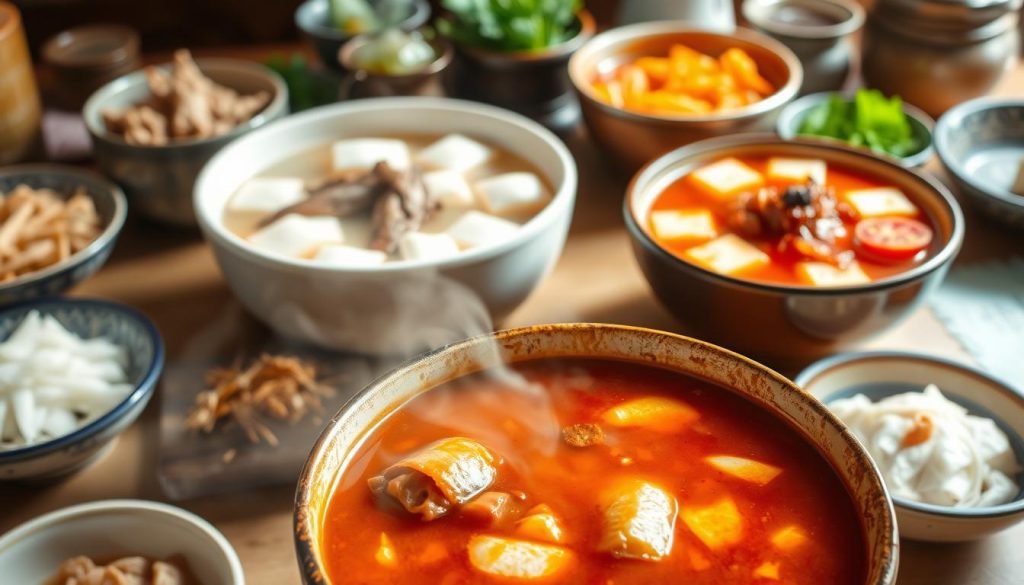
Popular Types of Korean Soups
Korean food has many soups and stews. Each one has its own special flavors and ingredients. Here are three favorites that many people love.
Kimchi Jjigae: A Classic Comfort
Kimchi Jjigae is a favorite Korean stew. It’s made with spicy kimchi and pork. It also has tofu and veggies, making it a comfort food for many.
People often eat it with rice. It’s perfect for when it’s cold outside.
Doenjang Jjigae: Miso Stew with Depth
This stew is loved in South Korea. It’s made with fermented soybean paste. It has potatoes, veggies, and sometimes tofu or meat.
It’s a hearty but mild dish. It’s a warm and healthy meal that goes well with rice.
Samgyetang: A Flavorful Ginseng Chicken Soup
Samgyetang is a refreshing and filling dish. It has a young chicken stuffed with rice and ginseng. It’s eaten in the summer to help with health and energy.
The broth is rich and aromatic. It shows how important health is in Korean food.
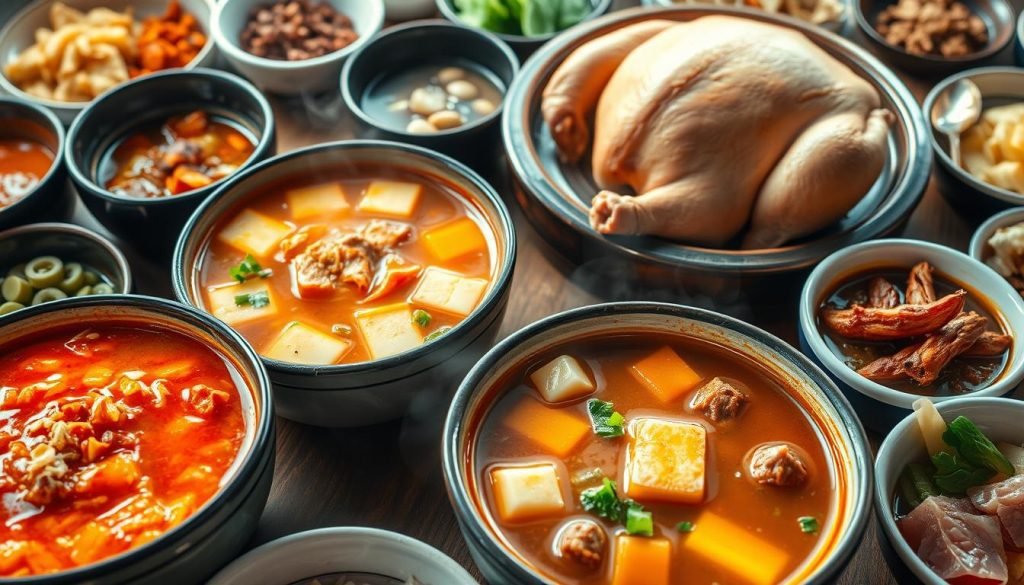
| Soup Type | Main Ingredients | Characteristics |
|---|---|---|
| Kimchi Jjigae | Fermented kimchi, pork, tofu, vegetables | Robust, comforting, served hot |
| Doenjang Jjigae | Fermented soybean paste, potatoes, veggies, tofu | Mild, nutritious, often homemade |
| Samgyetang | Young chicken, glutinous rice, ginseng | Rejuvenating, rich broth, health-focused |
Essential Cooking Techniques
Learning to cook Korean soups and stews is fun. You need to know some key techniques. These steps help make your dishes warm and tasty. You’ll get better at cooking and make easy recipes that everyone can do.
Mastering the Art of Broth Making
A good broth is the base of any soup or stew. Here’s how to make it great:
- Choose quality bones like beef, pork, or chicken for deep flavors.
- Simmer your stock for hours to get a richer taste.
- Add dried kelp and anchovies for a salty, savory taste.
How to Layer Flavors Effectively
Layering flavors makes your dish balanced. Here’s how to do it:
- Begin with garlic, onions, and ginger for a strong start.
- Add ingredients step by step, starting with proteins, then veggies.
- Use fermented foods like gochujang or kimchi to add more taste.
Tips for Perfecting Texture
Getting the right texture is key, for meats and veggies. Remember these tips:
- Choose the right tofu type—silken for stews, firmer for soups.
- Watch cooking times to make sure all ingredients work well together.
- Adjust spice levels slowly to please everyone’s taste.
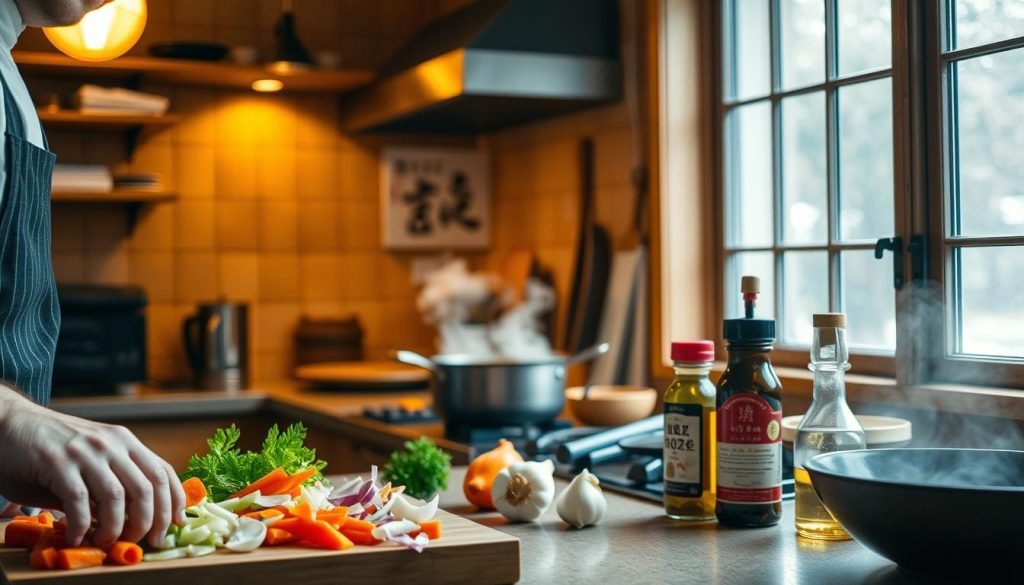
Health Benefits of Korean Soups & Stews
Korean soups and stews are tasty and good for you. They have healthy ingredients. A Korean meal often has rice, veggies, and protein.
This makes meals healthy. Korean food uses lots of veggies and less bad fats. It’s great for those who want Healthy Meals.
Nutritional Value of Common Ingredients
Korean soups have veggies, meats, and fermented foods. These ingredients make Korean meals lower in calories. They use less oil, making them nutritious.
Here’s what some key ingredients offer:
| Ingredient | Nutritional Benefits |
|---|---|
| Vegetables | Rich in vitamins, minerals, and fiber, supporting overall health and digestion. |
| Ginseng | Known to reduce fatigue, enhance energy levels, and possibly regulate blood sugar. |
| Fermented Foods (e.g., Kimchi) | Provide probiotics that may boost the immune system and aid digestion. |
Healing Properties of Ginseng
Ginseng is in dishes like Samgyetang. It’s known for its healing powers. It can increase energy and support overall health.
It helps you feel more alert in summer. Ginseng in Korean soups is good for fighting fatigue and boosting stamina.
The Role of Fermented Foods in Health
Fermented foods are big in Korean food. They help your gut health. Kimchi, a fermented dish, helps with weight, blood pressure, and cholesterol.
Eating fermented foods often is good for your digestion. It makes Korean soups a great choice for a healthy diet.
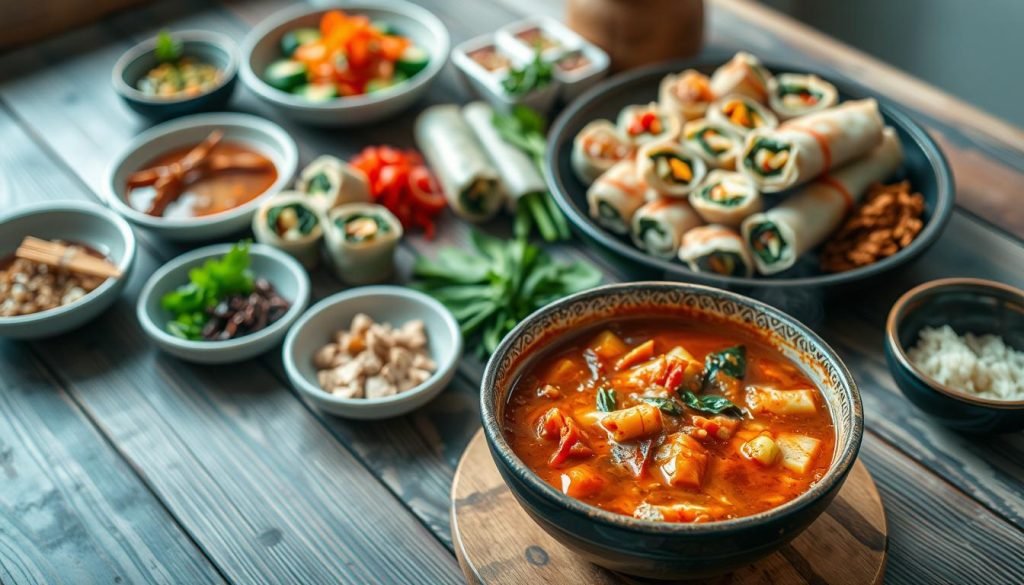
Regional Variations of Korean Soups
Korean food has many soups, each with its own taste. These soups show off local traditions and ingredients. From Seoul to Busan, each place has its own special soup.
Soups from Seoul vs. Busan
Seoul’s soups are modern and tasty. They mix old and new in a cool way. Busan, on the other hand, loves seafood soups. You’ll find haemultang, a seafood hot pot, full of clams, crabs, and prawns.
Traditional Recipes from Jeolla Province
Jeolla province uses the best local ingredients. Its soups have fresh veggies and fermented pastes. Try doenjang jjigae, a soybean paste stew, for a taste of tradition.
Unique Flavors from Gyeongsang Province
Gyeongsang province has soups that are full of flavor. You might find galbi-tang, a beef rib soup, or maeun-tang, a spicy fish hot pot. These soups show off the area’s farming and fishing.
Vegan and Vegetarian Korean Soups
Korean soups are great for vegans and vegetarians. You can make tasty dishes by using vegetable broth instead of meat. This way, you get delicious Vegan Korean Soups that are full of nutrients.
Finding Alternatives for Meat-Based Broths
For Vegetarian Korean Soups, a good vegetable broth is essential. It keeps the soup flavorful. You can use:
- Dried shiitake mushrooms
- Kombu (kelp)
- Onions and garlic for a nice smell
These add a rich umami taste. Your soup will still be tasty and filling, even without meat.
Delicious Vegan Kimchi Jjigae
Kimchi Jjigae is a favorite that can be made vegan. You’ll need:
- 12.3 ounces (349 grams) of silken tofu
- 4 tablespoons of gochujang for spice, adjust to taste
- Fresh veggies like zucchini and mushrooms for texture
This recipe is quick, taking just 30 minutes. It’s healthy, with about 198 calories per serving.
Hearty Vegetable Doenjang Jjigae
For a filling vegan option, try Vegetable Doenjang Jjigae. It includes:
- Silken or soft tofu
- Fresh mushrooms, zucchini, and potatoes for bulk
- 2-3 tablespoons of gochugaru to adjust heat
This soup is full of flavor and nutrients. It serves about 3 people. Plus, it’s ready in just 20 minutes.

How to Pair Korean Soups with Side Dishes
Pairing Korean soups with the right side dishes makes meals better. These small plates, called banchan, add variety and balance flavors. They help make your meal complete and enhance the soup’s taste.
Best Banchan to Complement Your Soup
Choosing the right banchan is key to enjoying Korean dishes. Here are some top picks:
- Kimchi: This fermented vegetable dish adds a tangy crunch that works well with most soups.
- Pickled Radish: Known as danmuji, its slight sweetness contrasts beautifully with spicier soups.
- Seasoned Spinach: A light, nutritious option that enhances the overall healthiness of your meal.
- Tofu Salad: Provides a creamy alternative that meshes well with the flavors of many soups.
Serving Suggestions for a Complete Meal
To make a satisfying meal, try these ideas:
- Serve a bowl of rice alongside your soup and banchan. This combination is traditional and fulfilling.
- Incorporate a light, refreshing salad to cleanse the palate between bites.
- Consider adding noodles, cooked separately, to add texture and heartiness to your meal.
- Experiment with different banchan each time to keep your meals exciting and interesting.
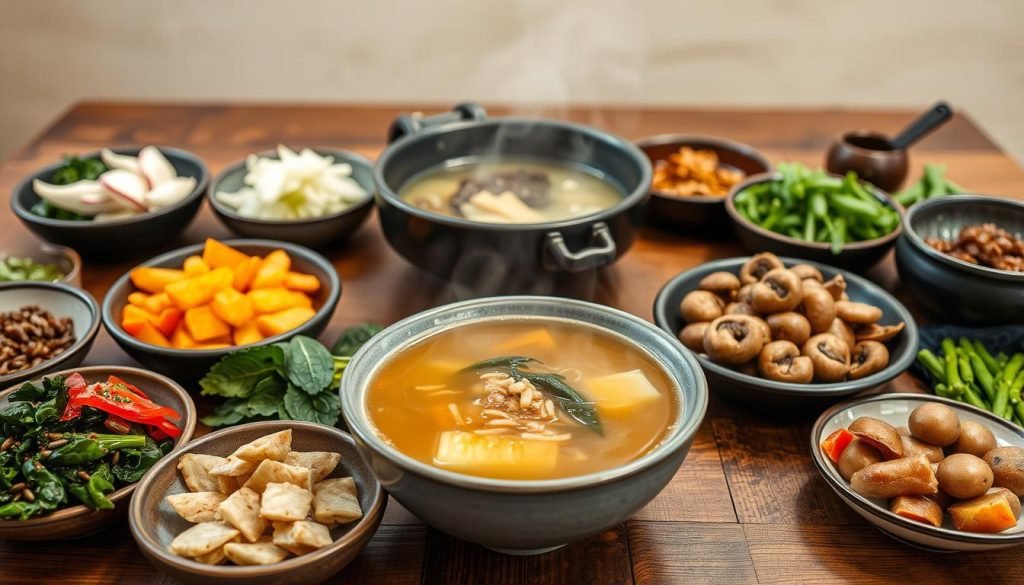
Cooking Tips for Beginners
Starting to cook Korean soups is exciting. You’ll learn important techniques and use essential tools. Whether it’s spicy kimchi-jjigae or other recipes, the right tools are key. Here are some tips to help you in your Korean cooking journey.
Essential Kitchen Tools You’ll Need
To begin your Korean cooking journey, get a few key tools. They will make cooking easier and better:
- Clay pots: Great for simmering stews and soups like kimchi-jjigae. They heat evenly.
- Sharp knives: Important for cutting ingredients. A good chef’s knife makes slicing veggies easy.
- Measuring cups and spoons: Important for getting the right flavor balance in your dishes.
- Mixing bowls: Useful for prepping and mixing sauces.
Common Mistakes to Avoid
New cooks often make simple mistakes that can ruin dishes. Watch out for these:
- Ignoring the broth: It’s key for flavor. Use homemade anchovy or chicken broth if you can.
- Adding too much spice too soon: Add seasonings slowly to control flavor. This makes the taste better.
- Not letting dishes rest: Letting your soup or stew rest for a few minutes before serving helps flavors mix well.
Simple Recipes to Start With
Beginner recipes help build kitchen confidence. Here are some easy ones to try:
- Kimchi Jjigae: A hearty stew with kimchi, pork, and anchovy broth. It’s a great way to start with Korean flavors.
- Doenjang Jjigae: A comforting soybean paste stew with lots of veggies. It’s a healthy choice.
- Vegetarian Guk: A mild soup that’s easy to make with different veggies. It shows Korean cooking’s flexibility.
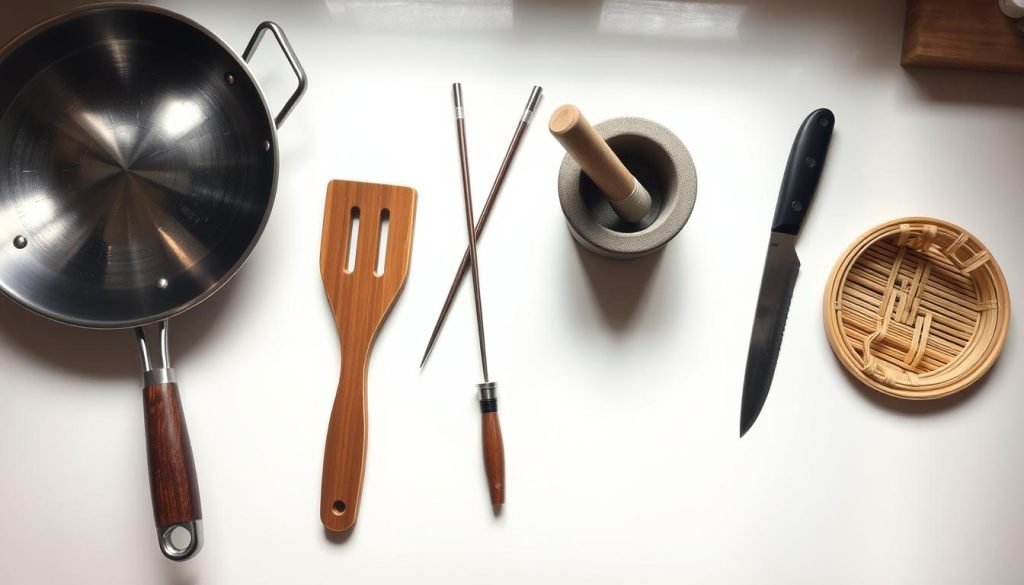
Storing and Reheating Korean Soups
Storing soups right lets you enjoy them for many meals. Korean soups need special care to stay tasty. Here are tips for storing leftovers and reheating soups well.
How to Properly Store Leftovers
Leftovers are great, and storing them right makes them last longer. Here’s how to store soups:
- Let the soup cool down before putting it in a tight container.
- Keep it in the fridge for 3-4 days.
- Freeze it in a safe container for up to 3 months.
- Use small containers for easier thawing and reheating.
Best Practices for Reheating
Reheating soups needs care to keep them tasty and smooth. Follow these tips for the best results:
- Reheat on medium heat, not boiling, to keep proteins and tofu soft.
- Stir often and add water or broth if it’s too thick.
- Make sure it’s hot enough, 165°F, before eating.
- Get creative with leftovers in dishes like bibimbap or fried rice.

By following these steps, you’ll enjoy Korean soups more. Storing and reheating tips will make your leftovers delicious.
DIY Kimchi: Key for Many Soups
Kimchi is key in many Korean soups and stews. It adds depth and a tangy flavor. Making your own DIY Kimchi lets you adjust the spice and ingredients to your liking. This ensures every bite is fresh.
This section will show you a basic kimchi recipe for beginners. You’ll also learn how to try different variations at home.
Basic Kimchi Recipe for Beginners
Making your first batch of kimchi is rewarding. Here’s a simple recipe to start with:
- Ingredients:
- 6 pounds (about 2.7 kg) of napa cabbage
- ½ cup (72 grams) of Kosher salt
- 2 cups of water
- 2 tablespoons of sweet rice flour
- 2 tablespoons of sugar
- 24 garlic cloves, minced
- 2 teaspoons of minced ginger
- 1 medium onion, chopped
- ½ cup of fish sauce
- ¼ cup of fermented salted shrimp (chopped, with brine)
- 2 cups of gochugaru (red pepper flakes)
- 1 large daikon radish (optional)
- 5 carrots (optional)
- 1 green pepper (optional)
- 2 leeks (optional)
Preparation Steps:
- Start by salting the napa cabbage with Kosher salt. Let it rest for 2 hours, stirring every 30 minutes.
- Make a porridge with water, sweet rice flour, and sugar. Let it cool down.
- Mix garlic, ginger, onion, fish sauce, fermented shrimp, and gochugaru into the cooled porridge.
- Combine the salted cabbage and optional vegetables with the spice mixture.
- Pack the kimchi into jars, leaving space at the top for fermentation gases to escape.
Fermentation starts in 1 to 2 days at room temperature. Move the kimchi to the fridge after fermentation is done. This can last 4-6 months.
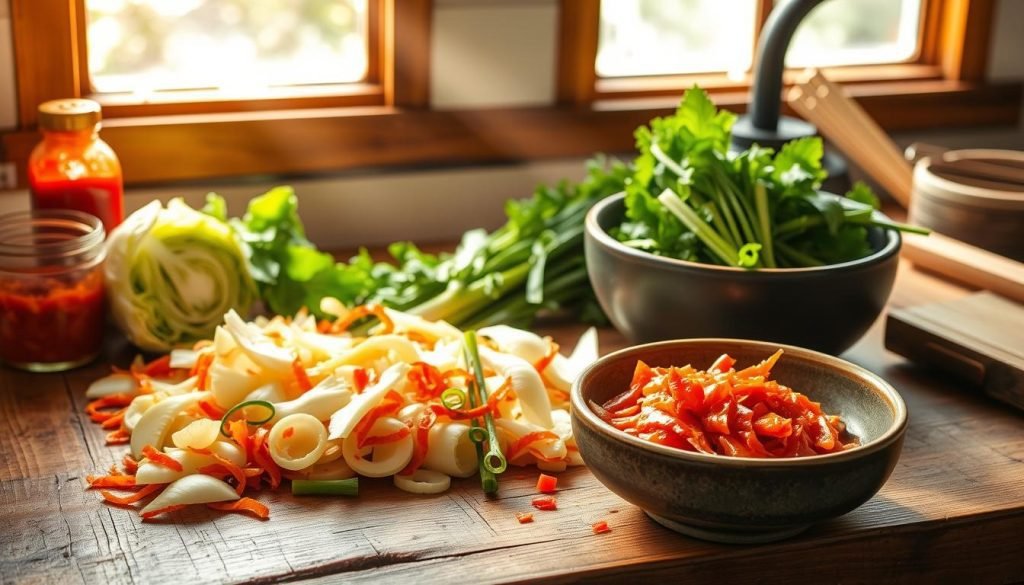
Variations to Try at Home
Try different ingredients and spice levels to change your DIY Kimchi. This will add variety to your Korean Cuisine. Here are some ideas:
- Spicy Kimchi: Add more gochugaru or sliced jalapeños for more heat.
- Vegetable Kimchi: Add seasonal vegetables like radishes and cucumbers.
- Sweet and Savory Kimchi: Add more sugar or use fruits like apple or pear for a sweeter taste.
- Seafood Kimchi: Add shrimp, squid, or oysters for a seafood twist.
By trying these kimchi recipes, you’ll not only improve your DIY skills. You’ll also make your Korean soups even better.
Hosting a Korean Soup Dinner
Hosting a Korean Dinner Party is fun and exciting. It makes your guests happy and brings people together. Planning your menu well is key. This way, you have many tasty soups and dishes for everyone.
Decorating your space right makes the dinner even better. It brings the real Korean culture to your home. Talking about the food with your guests makes the evening more fun.
Planning Your Menu
Choosing the right soups is the first step. Pick ones that taste good together. Think about different flavors and textures.
- Kimchi Jjigae: A hearty kimchi stew that warms the soul.
- Samgyetang: Ginseng chicken soup, known for its comforting qualities.
- Doenjang Jjigae: Miso stew that provides depth and richness.
Rice is a big part of Korean meals. Serve it with traditional banchan like:
- Kimchi: A staple in every Korean meal.
- Japchae: Stir-fried glass noodles that offer a delightful bite.
- Sigeumchi Namul: Sautéed spinach for a healthy side option.
This mix of dishes makes your table look great. It also meets different tastes.
Setting the Mood with Decor
Creating a welcoming space is important. Use Korean items in your decor, such as:
- Traditional tableware, including flat chopsticks.
- Colorful tablecloths or mats that reflect Korean aesthetics.
- Fresh flowers or ornamental items that symbolize good fortune.
Set up your dining area for everyone to share. Serve all dishes at once. This makes your dinner party more fun and interactive.
Engaging Your Guests with Tasting Notes
Help your guests enjoy the food more by giving them Tasting Notes. These notes can include:
- The unique ingredients of each soup and how they enhance flavor.
- Brief histories of traditional dishes, connecting them to Korean culture.
- Suggested pairings of banchan that elevate the dining experience.
Writing about these interesting facts starts great conversations. Your dinner party becomes both enjoyable and educational. It’s a chance to share delicious food and learn about Korean culture together.
| Soup/Stew | Main Ingredient | Characteristics |
|---|---|---|
| Kimchi Jjigae | Kimchi | Spicy, warming, rich in umami |
| Samgyetang | Chicken | Comforting, herbal, nutritious |
| Doenjang Jjigae | Miso | Earthy, savory, hearty |
Conclusion: Your Journey with Korean Soups
Now you’ve seen the wide world of Korean soups. It’s time to start your own adventure. Korean soups are more than just warm comfort. They let you play with flavors and ingredients you like.
Try changing the spice or adding new veggies. Making your own version of these recipes is fun.
Encouragement to Experiment
As you make more Korean soups, remember to try new things. Mix ingredients and try odd pairings. You might find a new favorite dish.
The best thing about these soups is how you can make them your own. You can keep their rich history while making them your own.
Resources for Further Exploration
If you want to learn more about Korean soups, there are many resources. Look for cookbooks on Korean food, visit websites about cooking, or follow Korean food chefs on social media.
These places can teach you new things and make your cooking fun and rewarding.